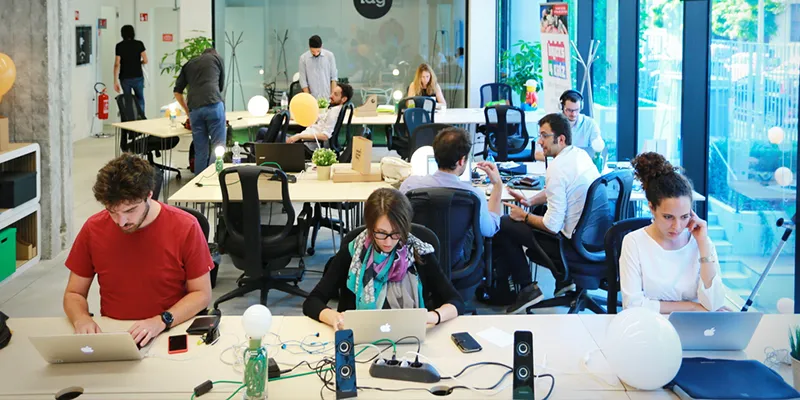7 reasons why the coworking future looks bright
The coworking office is the way forward as companies, entrepreneurs and teams look to office space providers to enhance their work life, their personal space and add value to each dimension.
The past few years have witnessed an unparalleled success for the coworking juggernaut in India. This accelerated growth has stemmed from the revolutionary shift in the Indian traditional workspace to a more flexible, accessible and affordable coworking space. In the first quarter of 2018 itself, coworking had transacted about 2 million square feet commercial realty; way ahead of the 1.8 mn sq ft in 2017.
The industry is expected to grow 3X by 2021, leading to massive opportunities for the coworking business in the country. Coworking has now established itself as a fundamental part of the CRE leasing activity and a full-fledged sector in its own right, giving tough competition to conventional office spaces.
Additionally, fuelling this considerable progress is the rising entrepreneurial spirit, which is seeping into Tier II cities as well. Tier II markets are expected to grow to 8.5 mn seats by 2020. Thus, given the strong demand and impetus that it has been able to garner, it wouldn’t be an exaggeration to suggest that the best is yet to come for a segment which is still in the nascent stages of development.

Inherently collaborative and flexible by nature, coworking has observed many new trends and unique practices over the years. Fierce competition and ever-growing demand have led to several leading players putting on their brainstorming hats to ensure sustained market relevance and retain clients with value-added benefits.
While the past few years have unearthed some strong trends, which have redefined the future of the segment, we expect the momentum to strongly continue in 2019 as well.
Here are the top seven trends that we foresee will become the game-changes in the industry.
Coworking players handholding developers in managing experiences
The business relationship between a developer and a coworking space provider is now no longer confined to just leasing the commercial space. Not only are coworking spaces going beyond setting up workspaces and partnering with developers to enable them to get higher returns, they are also handholding developers by marketing and representing other floors in the building to clients on conventional lease.
Coworking players are curating unique experiences and engagements for building tenants by providing state-of-the-art amenities like gyms, cafés, creches and managing the complete building ecosystem by bringing alliances, events and community focus to the occupants.
Coworking players foraying into coliving
Expansion and business diversity is the key to sustained growth for any company. While coworking space providers have successfully bridged the gap between supply and demand in India’s office spaces, this has now also extended to the residential real estate market wherein millennials are now getting used to the concept of coliving.
This is a perfect arrangement to target millennials whilst solving the problem of traditional accommodation with all-inclusive amenities and community events. While this is still untested waters, we look forward to seeing more use cases in 2019 and evaluating its success.
Deeper technology integration
The traditional desk will likely be non-existent in the next three years, with wearable technology and AI gradually taking over coworking spaces and transforming them into autonomous workspaces. Smart access, smart meeting rooms and smart receptions have already forayed enabling cloud-based access system, facial recognition and real time security monitoring.
Virtual assistants, AI powered ambience and temperature control and touch screen-based collaborations are improving user experience. The laptop and smartphone will become redundant as voice activated systems, wearable technology including wearable glasses, embedded chips, and wrist devices connected with Internet of Things (IoT) will take centre-stage and the connection of working professionals with fixed work desks will become a passé.
Video technology and connectivity speed will ensure real presence without travel. Artificial intelligence will, in fact, even corroborate furniture shape, size and use as per user accumulated data.
Rise of ‘work near home’ programmes
The number of people preferring to live close to their workplaces or vice-versa is on the rise and “walk to work” is a trend that is quickly picking up in metro cities as it saves productive man hours instead of losing time to traffic congestion for hours while commuting to work.
Owing to multiple locations, inter-city as well as intra-city, coworking spaces are the solution to reduce commute hour and provide both personal as well as business benefits. In order to provide more employee friendly policies, companies have been exploring the option of allowing employees to “work from home.”
However, due to inherent challenges like
a. Distractions at home
b. Unavailability of right infrastructure (high speed internet, printer, desk space)
c. Lack of social interactions/peer to peer engagements, there is a significant loss in productivity.
This is prompting more and more companies to explore “work near home” – allowing employees to work remotely out of shared spaces while having access to effective office infrastructure.
Adoption of flexible and mobile solutions
The number of transactions for “just-in-time” usage of meeting rooms and mobility passes has increased three folds over the past two years, and for most players, it is growing at the rate of more than 12 percent per month.
Businesses today are expanding to multiple geographies and servicing clients throughout the country. As a result, the workforce cannot always be expected, and required, to work out of a handful of central locations. The current workforce needs to be geographically dispersed as well as to be on-the-move as per the demands of the job.
Millennials and Gen Z employees are seeking flexibility, mobility, collaboration and options that help them work real-time and untethered. Shared workspaces enable flexibility by providing solutions such as national pass, roaming and bulk meeting room hours to work out of any location, without any restriction and hassle of booking each time.
Virtual offices benefit businesses based out of small towns, looking to setup a professional address or have a footprint in larger cities/ metros as their central business districts.
Holistic enterprise solutions
Shared workspace providers are foraying into creating and managing independent offices for enterprises along with running the coworking business. The process starts right from identifying a suitable space to construction, customisations and providing complete back-end support on technology and operations of the office space.
This is a hassle-free way for an enterprise to outsource the designing, building and managing of their “own” office space thus allowing them to focus on running their business and not their office.
Platform for collaboration
Coworking spaces not only provide real estate solutions and hassle-free management but also offer an ideal platform for members to leverage business opportunities. With so many diverse companies sitting next to each other, the interactions are seamless and collaborations aplenty.
Often times, the collaboration also happens between the coworking space provider and the clients sitting within through retailing and sampling of products and services. The clients get real time feedback from the larger community and opportunity to test the market with varied demographics.
The workplace transformation has begun in earnest and will see some major transformations in the next 5-7 years as people’s lifestyles evolve, technology advancements take place at a fast pace, office commute times increase, and health and well - being takes centre stage. This will place the office worker at the heart of all office space solutions.
(Disclaimer: The views and opinions expressed in this article are those of the author and do not necessarily reflect the views of YourStory.)
(Edited by Suruchi Kapur- Gomes)









